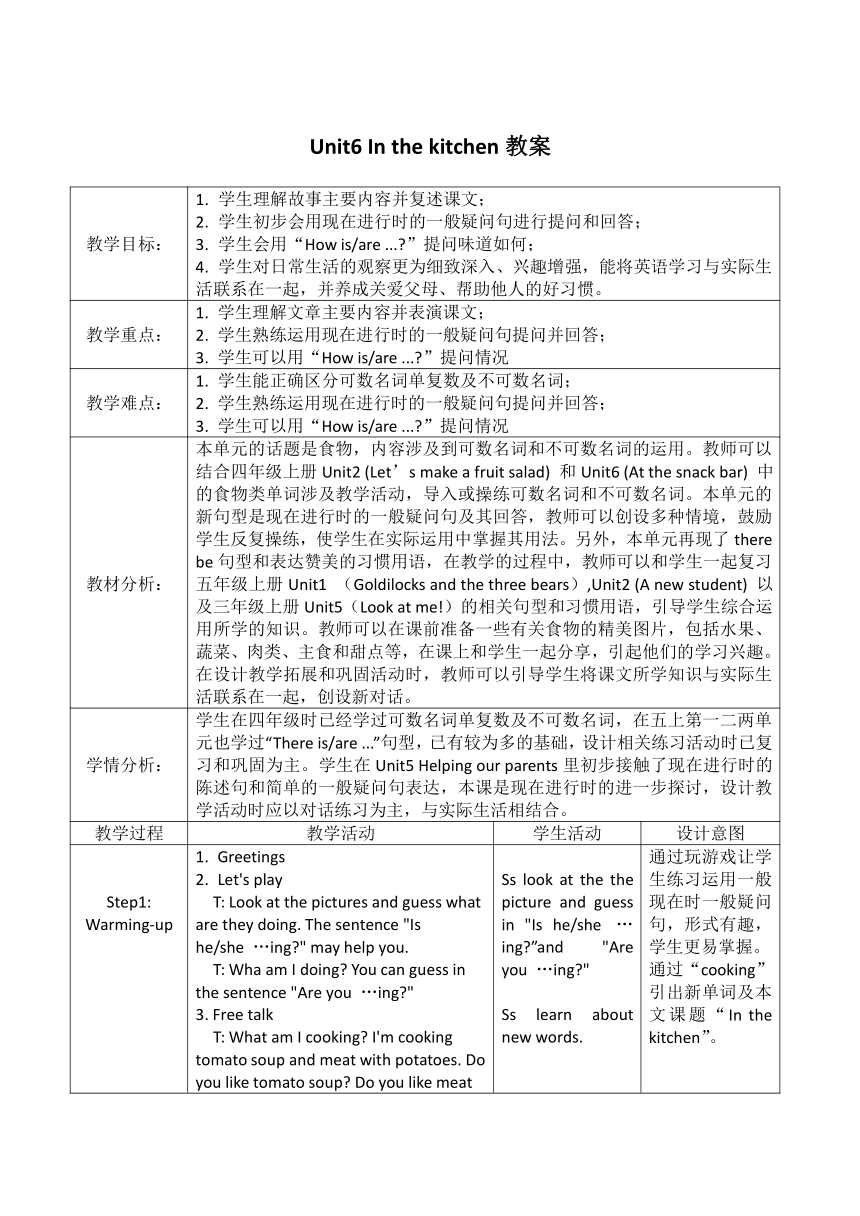Unit 6 In the kitchen 教案(表格式)
文档属性
| 名称 | Unit 6 In the kitchen 教案(表格式) |

|
|
| 格式 | zip | ||
| 文件大小 | 8.3KB | ||
| 资源类型 | 教案 | ||
| 版本资源 | 牛津译林版 | ||
| 科目 | 英语 | ||
| 更新时间 | 2019-05-19 08:35:19 | ||
图片预览

文档简介
Unit6 In the kitchen教案
教学目标:
学生理解故事主要内容并复述课文;
学生初步会用现在进行时的一般疑问句进行提问和回答;
学生会用“How is/are ...?”提问味道如何;
学生对日常生活的观察更为细致深入、兴趣增强,能将英语学习与实际生活联系在一起,并养成关爱父母、帮助他人的好习惯。
教学重点:
学生理解文章主要内容并表演课文;
学生熟练运用现在进行时的一般疑问句提问并回答;
学生可以用“How is/are ...?”提问情况
教学难点:
学生能正确区分可数名词单复数及不可数名词;
学生熟练运用现在进行时的一般疑问句提问并回答;
学生可以用“How is/are ...?”提问情况
教材分析:
本单元的话题是食物,内容涉及到可数名词和不可数名词的运用。教师可以结合四年级上册Unit2 (Let’s make a fruit salad) 和Unit6 (At the snack bar) 中的食物类单词涉及教学活动,导入或操练可数名词和不可数名词。本单元的新句型是现在进行时的一般疑问句及其回答,教师可以创设多种情境,鼓励学生反复操练,使学生在实际运用中掌握其用法。另外,本单元再现了there be句型和表达赞美的习惯用语,在教学的过程中,教师可以和学生一起复习五年级上册Unit1 (Goldilocks and the three bears),Unit2 (A new student) 以及三年级上册Unit5(Look at me!)的相关句型和习惯用语,引导学生综合运用所学的知识。教师可以在课前准备一些有关食物的精美图片,包括水果、蔬菜、肉类、主食和甜点等,在课上和学生一起分享,引起他们的学习兴趣。在设计教学拓展和巩固活动时,教师可以引导学生将课文所学知识与实际生活联系在一起,创设新对话。
学情分析:
学生在四年级时已经学过可数名词单复数及不可数名词,在五上第一二两单元也学过“There is/are ...”句型,已有较为多的基础,设计相关练习活动时已复习和巩固为主。学生在Unit5 Helping our parents里初步接触了现在进行时的陈述句和简单的一般疑问句表达,本课是现在进行时的进一步探讨,设计教学活动时应以对话练习为主,与实际生活相结合。
教学过程
教学活动
学生活动
设计意图
Step1: Warming-up
Greetings
Let's play
T: Look at the pictures and guess what are they doing. The sentence "Is he/she …ing?" may help you.
T: Wha am I doing? You can guess in the sentence "Are you …ing?"
3. Free talk
T: What am I cooking? I'm cooking tomato soup and meat with potatoes. Do you like tomato soup? Do you like meat with potatoes? Where am I cooking?
Ss look at the the picture and guess in "Is he/she …ing?”and "Are you …ing?"
Ss learn about new words.
通过玩游戏让学生练习运用一般现在时一般疑问句,形式有趣,学生更易掌握。
通过“cooking”引出新单词及本文课题“In the kitchen”。
Step2: While-reading
Look&guess
T: Look at the picture. What can you know from the picture?
T: What else do you want to know about the picture? You can ask some questions.
Listen& answer
Q1: What time is it?
Q2: What are they doing?
Watch&choose
Q: What do they have for dinner?
Read&ask
T: Who is cooking tomato soup and who is cooking meat with potatoes? Read picture1 in pairs and ask and answer.
Read &find
T: What about Liu Tao?What is Liu Tao doing? Read Picture2 and find the answer.
Read&underline
T: Dinner is ready. How is the dinner. Read Pic3 indepen dently and underline the key sentences.
T: What else can we say to praise others?
Reading time
Show time
S: They are Liu Tao, Mr Liu and Mrs Liu. They are in the kitchen.
S: What are they doing?
S: It's six o'clock.
They are cooking
S: They have tomato soup and meat with potatoes.
S1: Is … cooking …?
S2:Yes,he/sheis.
No, he/she isn't.
S: He is looking for juice in the fridge.
S: It's yummy./ It's nice.
Ss read after the tape.
Ss work in groups of four and choose one or two scenes to act.
学生看图说话并提问题,锻炼了学生从图片中提取信息的能力,也帮助学生拓展发散思维。
听力练习帮助学生训练听力能力。
学生自读课文合作练习问答,既训练了学生精读能力,有帮助学生巩固练习现在进行时的一般疑问句。
学生自读课文找答句,对“It's yummy.”的用法有语境意识,并且配合动作,加深印象。
学生小组表演课文时根据实际情况增添了对话,很好完成知识点内化及运用。
Step3: Expanding
After school
T: Liu Tao is hungry after a football game. Maybe you are hungry after school too. Imagine what will happen when you come home.
Ss create new dialogues like the story and add more actions.
小组合作表演对话帮助学生实际应用所学句子,加深学生对重点句型的情景理解,完成课本到实际的转化。
Step4: Homework
Read the story after the tape.
2. Make new dialogues and communicate with your family and friends.
Blackboard design
Are you ...ing?
Yes, I am./ No, I’m not.
Is he/she ...ing?
Yes, he/she is./ No. He/she isn’t.
How is …?
It's ….
教后反思
课堂设计应该围绕重点句型及课文呈现形式设计,例如本课课文是以对话形式呈现,那么问答类的口语练习可以帮助学生更好的理解句子用法,这是我在设计活动时忽视的。其次,我在最初的课堂设计中没有为学生创造和本课主题相关的实际语境。本课主题为 “In the kitchen”,课文中的重点句型也与厨房相关,课堂导入、课堂问答与拓展练习的实际语境也应与此相关,这样才有助于学生内化句子并正确使用它们。教授新词时,枯燥乏味的跟读、重复效率低且会消耗学生热情,给新词提供适宜的语境句子会让学生轻松掌握并理解运用语境,这也是我没有考虑到的。课堂中的小组活动,学生自由延伸能体现他们的学习成效,也需要教师的合理指导。课堂氛围既需要有趣生动的课堂活动活跃,也离不开教师亲切又活泼的教态的活跃,这需要我在今后的教学中时刻注意的问题。导入部分的free talk可针对学生实际进一步复习食物,为最后的拓展做铺垫。
教学目标:
学生理解故事主要内容并复述课文;
学生初步会用现在进行时的一般疑问句进行提问和回答;
学生会用“How is/are ...?”提问味道如何;
学生对日常生活的观察更为细致深入、兴趣增强,能将英语学习与实际生活联系在一起,并养成关爱父母、帮助他人的好习惯。
教学重点:
学生理解文章主要内容并表演课文;
学生熟练运用现在进行时的一般疑问句提问并回答;
学生可以用“How is/are ...?”提问情况
教学难点:
学生能正确区分可数名词单复数及不可数名词;
学生熟练运用现在进行时的一般疑问句提问并回答;
学生可以用“How is/are ...?”提问情况
教材分析:
本单元的话题是食物,内容涉及到可数名词和不可数名词的运用。教师可以结合四年级上册Unit2 (Let’s make a fruit salad) 和Unit6 (At the snack bar) 中的食物类单词涉及教学活动,导入或操练可数名词和不可数名词。本单元的新句型是现在进行时的一般疑问句及其回答,教师可以创设多种情境,鼓励学生反复操练,使学生在实际运用中掌握其用法。另外,本单元再现了there be句型和表达赞美的习惯用语,在教学的过程中,教师可以和学生一起复习五年级上册Unit1 (Goldilocks and the three bears),Unit2 (A new student) 以及三年级上册Unit5(Look at me!)的相关句型和习惯用语,引导学生综合运用所学的知识。教师可以在课前准备一些有关食物的精美图片,包括水果、蔬菜、肉类、主食和甜点等,在课上和学生一起分享,引起他们的学习兴趣。在设计教学拓展和巩固活动时,教师可以引导学生将课文所学知识与实际生活联系在一起,创设新对话。
学情分析:
学生在四年级时已经学过可数名词单复数及不可数名词,在五上第一二两单元也学过“There is/are ...”句型,已有较为多的基础,设计相关练习活动时已复习和巩固为主。学生在Unit5 Helping our parents里初步接触了现在进行时的陈述句和简单的一般疑问句表达,本课是现在进行时的进一步探讨,设计教学活动时应以对话练习为主,与实际生活相结合。
教学过程
教学活动
学生活动
设计意图
Step1: Warming-up
Greetings
Let's play
T: Look at the pictures and guess what are they doing. The sentence "Is he/she …ing?" may help you.
T: Wha am I doing? You can guess in the sentence "Are you …ing?"
3. Free talk
T: What am I cooking? I'm cooking tomato soup and meat with potatoes. Do you like tomato soup? Do you like meat with potatoes? Where am I cooking?
Ss look at the the picture and guess in "Is he/she …ing?”and "Are you …ing?"
Ss learn about new words.
通过玩游戏让学生练习运用一般现在时一般疑问句,形式有趣,学生更易掌握。
通过“cooking”引出新单词及本文课题“In the kitchen”。
Step2: While-reading
Look&guess
T: Look at the picture. What can you know from the picture?
T: What else do you want to know about the picture? You can ask some questions.
Listen& answer
Q1: What time is it?
Q2: What are they doing?
Watch&choose
Q: What do they have for dinner?
Read&ask
T: Who is cooking tomato soup and who is cooking meat with potatoes? Read picture1 in pairs and ask and answer.
Read &find
T: What about Liu Tao?What is Liu Tao doing? Read Picture2 and find the answer.
Read&underline
T: Dinner is ready. How is the dinner. Read Pic3 indepen dently and underline the key sentences.
T: What else can we say to praise others?
Reading time
Show time
S: They are Liu Tao, Mr Liu and Mrs Liu. They are in the kitchen.
S: What are they doing?
S: It's six o'clock.
They are cooking
S: They have tomato soup and meat with potatoes.
S1: Is … cooking …?
S2:Yes,he/sheis.
No, he/she isn't.
S: He is looking for juice in the fridge.
S: It's yummy./ It's nice.
Ss read after the tape.
Ss work in groups of four and choose one or two scenes to act.
学生看图说话并提问题,锻炼了学生从图片中提取信息的能力,也帮助学生拓展发散思维。
听力练习帮助学生训练听力能力。
学生自读课文合作练习问答,既训练了学生精读能力,有帮助学生巩固练习现在进行时的一般疑问句。
学生自读课文找答句,对“It's yummy.”的用法有语境意识,并且配合动作,加深印象。
学生小组表演课文时根据实际情况增添了对话,很好完成知识点内化及运用。
Step3: Expanding
After school
T: Liu Tao is hungry after a football game. Maybe you are hungry after school too. Imagine what will happen when you come home.
Ss create new dialogues like the story and add more actions.
小组合作表演对话帮助学生实际应用所学句子,加深学生对重点句型的情景理解,完成课本到实际的转化。
Step4: Homework
Read the story after the tape.
2. Make new dialogues and communicate with your family and friends.
Blackboard design
Are you ...ing?
Yes, I am./ No, I’m not.
Is he/she ...ing?
Yes, he/she is./ No. He/she isn’t.
How is …?
It's ….
教后反思
课堂设计应该围绕重点句型及课文呈现形式设计,例如本课课文是以对话形式呈现,那么问答类的口语练习可以帮助学生更好的理解句子用法,这是我在设计活动时忽视的。其次,我在最初的课堂设计中没有为学生创造和本课主题相关的实际语境。本课主题为 “In the kitchen”,课文中的重点句型也与厨房相关,课堂导入、课堂问答与拓展练习的实际语境也应与此相关,这样才有助于学生内化句子并正确使用它们。教授新词时,枯燥乏味的跟读、重复效率低且会消耗学生热情,给新词提供适宜的语境句子会让学生轻松掌握并理解运用语境,这也是我没有考虑到的。课堂中的小组活动,学生自由延伸能体现他们的学习成效,也需要教师的合理指导。课堂氛围既需要有趣生动的课堂活动活跃,也离不开教师亲切又活泼的教态的活跃,这需要我在今后的教学中时刻注意的问题。导入部分的free talk可针对学生实际进一步复习食物,为最后的拓展做铺垫。
